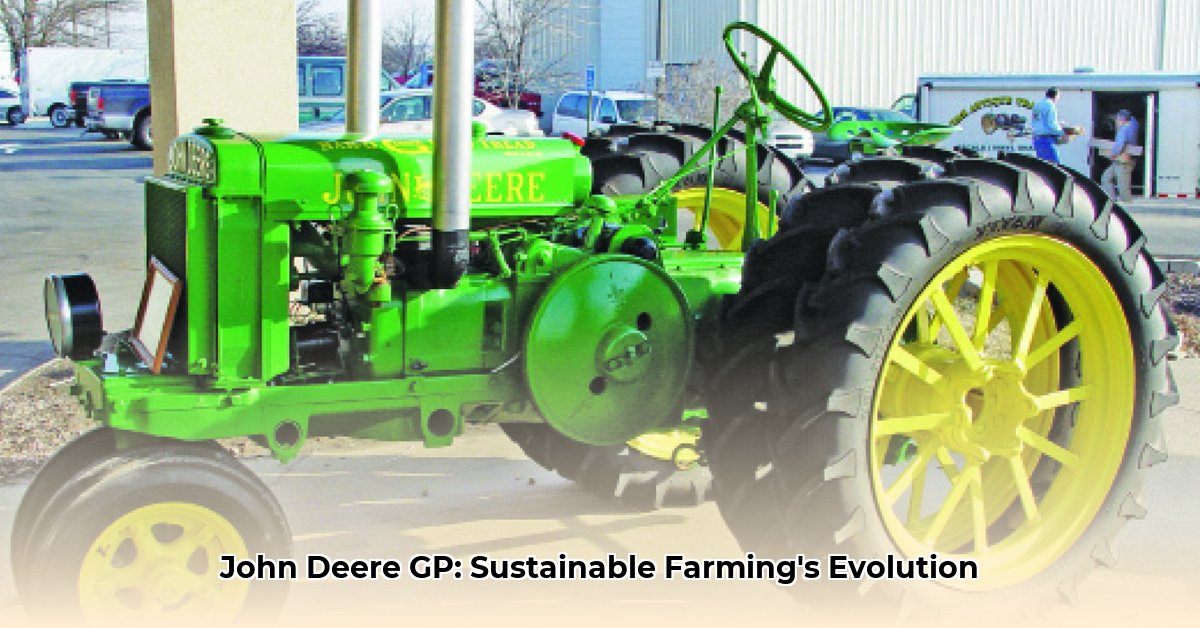
The John Deere GP tractor, a seemingly humble machine from the 1930s, offers a compelling case study in the evolution of sustainable agriculture. While not possessing the technological sophistication of modern tractors, its impact on farming practices—particularly its contribution to efficiency and adaptability—remains significant. This article analyzes the GP's role in shaping early mechanized farming, exploring its technical specifications, impact on farming practices, and ultimately, its legacy within the broader context of sustainable agricultural development. For a look at more modern John Deere tractors, check out this page.
The Agricultural Landscape of the 1930s
Imagine the American Midwest during the Great Depression. Farming was a backbreaking endeavor, heavily reliant on animal power and manual labor. Yields were low, and the process was incredibly time-consuming. The Dust Bowl exacerbated these challenges, creating widespread land degradation. This context highlights the desperate need for tools that could increase efficiency and ease the burden on farmers. The John Deere GP tractor emerged as a potential solution, though its impact on sustainability requires careful analysis. What were the underlying economic and environmental pressures that made a machine like the GP so appealing?
Technical Specifications and Design
The John Deere GP tractor boasted a modest two-cylinder engine, generating only 14 horsepower (a far cry from today's standards). This engine, often fueled by kerosene (a less environmentally friendly fuel than modern alternatives), was paired with a three-speed transmission. Simplicity was key; the design was straightforward and easily repairable by farmers themselves, a crucial factor considering the limited access to specialized mechanics in rural areas. Its revolutionary advantage, however, lay in its adaptability to different farm tasks and soil conditions. How did this simple design translate to increased efficiency in the field?
Impact on Farming Practices
The John Deere GP significantly improved farming efficiency, especially in row-crop cultivation and orchards. While precise quantitative data from that era is scarce, anecdotal evidence and expert analysis point to considerable gains in productivity. The tractor's ability to work longer hours and at a faster rate than animal-powered methods reduced labor requirements per acre. Furthermore, the tractor's adaptability, thanks to available modifications, allowed it to tackle various tasks which further enhanced efficiency. Did these gains in efficiency come at an environmental cost?
Sustainability Assessment: A Complex Equation
Evaluating the GP's environmental impact requires a nuanced approach. While kerosene fuel wasn't environmentally ideal, the reduction in manual labor and animal power had unintended environmental consequences. Fewer workers meant fewer transportation emissions, and reduced reliance on animal power lessened the demand for feed production, a process with its own carbon footprint and land-use consequences. However, the manufacturing process of the tractor itself, along with the fuel's emission profile, must be factored into any complete environmental assessment. This necessitates further research for a definitive conclusion on the GP's overall sustainability. What are the significant gaps in our understanding of the GP's environmental impact?
Variants and Adaptations: The GPWT, GPO, and GP-P
The John Deere GP was not a static design. Variants like the GPWT (Wide Tread), designed for better traction in soft soils; the GPO (Orchard), optimized for narrow rows; and the GP-P (with power take-off), enabling the use of auxiliary equipment, demonstrate a remarkable early adoption of customization within agricultural technology. These modifications illustrate the growing awareness of the need for niche-specific tools tailored to diverse farming needs, a concept driving much of modern precision agriculture. How did the adaptation of the GP design reflect a wider trend in agricultural technology?
Long-Term Legacy and Conclusions
The John Deere GP tractor, despite its technical limitations by today's standards, holds a significant place in agricultural history. It exemplified a pivotal moment of transition – from animal power to mechanization. While its impact on sustainable farming practices remains a subject necessitating further research, its contribution to increased efficiency and the concept of specialized agricultural equipment cannot be understated. What are the crucial lessons from the GP that can inform sustainable agricultural practices?
Further Research
Several key areas require additional investigation for a more comprehensive understanding:
- Quantifying the GP's efficiency gains precisely, contrasting with pre-mechanized methods.
- Conducting a full life-cycle assessment of the GP, examining its environmental impact from manufacturing to disposal.
- Comparative analysis of the GP's environmental performance against alternative technologies of its era.
Key Takeaways:
- The John Deere GP tractor, while not perfectly sustainable by today's standards, played a pivotal role in increasing efficiency and adaptability in early 20th-century farming.
- Its diverse variants (GPWT, GPO, GP-P) heralded the rise of specialized agricultural machinery, an essential component of modern sustainable farming.
- Further research is needed to fully quantify the GP's overall environmental impact compared to human and animal-powered farming, acknowledging both advantages and disadvantages.
The John Deere GP's story is a testament to the enduring need for innovation in agriculture and a reminder that the quest for sustainable practices is an ongoing, evolving process.